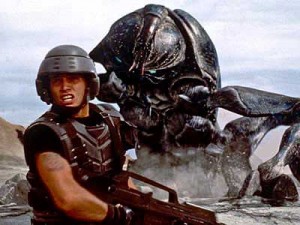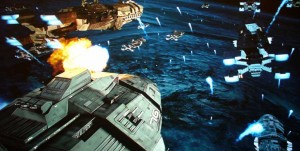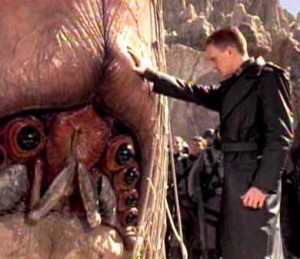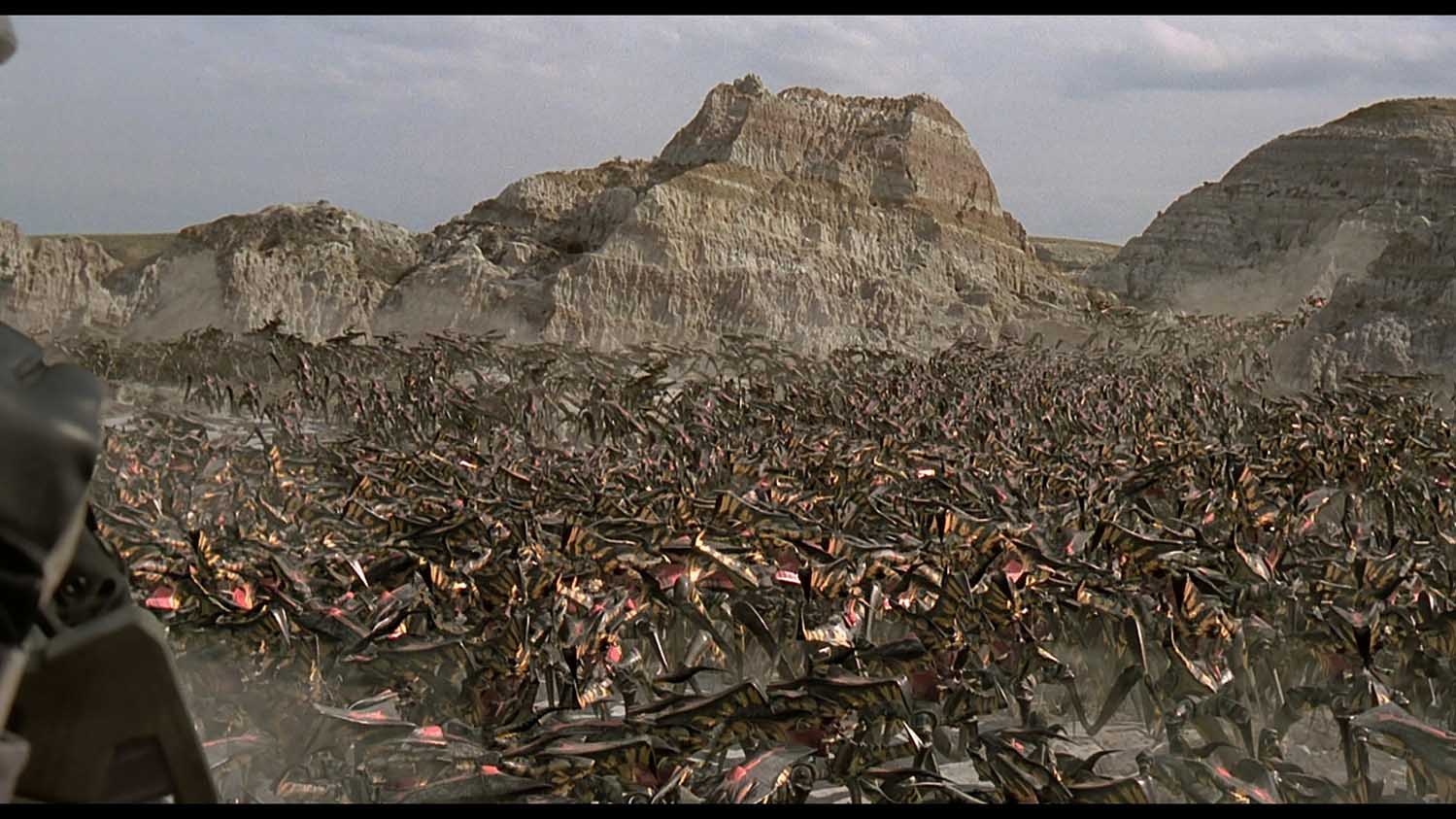 In 1997, when, in a panic about the runaway budget of Titanic, Hollywood had canceled mega-budget genre projects including Tim Burton’s Superman and an Incredible Hulk feature film, one science-fiction blockbuster slipped through the cracks: Paul Verhoeven’s Starship Troopers. In a time before the Star Wars prequels, Starship Troopers, based on Robert Heinlein’s beloved 1959 novel, with no A-list stars, had a relatively lean budget of just under $100 million, relegating costs almost entirely to locations, production design and visual effects. With the success of Jurassic Park coming just a few years before Starship Troopers‘ green light, a hybrid of techniques would be implemented to realize the film’s complex manifestation of space travel and foreign worlds, not to mention its exotic creatures.
In 1997, when, in a panic about the runaway budget of Titanic, Hollywood had canceled mega-budget genre projects including Tim Burton’s Superman and an Incredible Hulk feature film, one science-fiction blockbuster slipped through the cracks: Paul Verhoeven’s Starship Troopers. In a time before the Star Wars prequels, Starship Troopers, based on Robert Heinlein’s beloved 1959 novel, with no A-list stars, had a relatively lean budget of just under $100 million, relegating costs almost entirely to locations, production design and visual effects. With the success of Jurassic Park coming just a few years before Starship Troopers‘ green light, a hybrid of techniques would be implemented to realize the film’s complex manifestation of space travel and foreign worlds, not to mention its exotic creatures.
Chief among Verhoeven’s key team was Phil Tippett, a classically-trained stop-motion animator who had worked on creature and effects shots at Industrial Light and Magic on the original Star Wars trilogy, on the three Robocop films and as a “dinosaur consultant” on Jurassic Park. And though Jurassic Park‘s initial plan for Tippett’s go-motion animation to bring to life its full-size dinosaur movements was entirely replaced by ILM’s computer-generated animation, Tippett joined the CG generation of filmmakers immediately following that film, converting his East Bay Area studio into a CGI animation facility. In fact, as a test of sorts for the over 250 CG animation shots that Starship Troopers would require, for the 1996 film Tremors 2: Aftershocks, Tippett attempted many such shots using CG creatures that would go on to resemble the look and movement of the bugs in Troopers.
Many tests of various bugs occurred in this period at Tippett’s studio in planning for Troopers‘ myriad bug scenes, all of which were composited into background plates with actors that were filmed on location in Wyoming and South Dakota, doubling as the bugs’ home planets. Tippett’s art director Craig Hayes has been credited by Tippett himself with designing the bugs, including the fierce warrior bugs, the flying hopper bugs, the massive fire-spewing tanker bugs, the meteor-shooting plasma bugs, and the last one seen in the film, the brain bug.
To match the Tippett-created CG bugs, Amalgamated Dynamics created full and partial live-action bug counterparts in their Southern California studio. Co-founders Alec Gillis and Tom Woodruff, Jr. worked on locations with their sizable team of mechanics and puppeteers to bring the bugs to life in scenes which directly involved the actors. For wide shots, real actors were composited with Tippett’s bugs or computer-generated humans were utilized. Additionally, special makeup effects supervisor Kevin Yagher created live-action human puppets, corpses and gags which worked on set in real-time. Only a close evaluation of the film can reveal which shots were ADI and Yagher’s work vs. Tippett’s material, but most close-ups and partial bug shots were accomplished in live-action while wider material typically featured Tippett’s work. In this way, the film was created very much like Jurassic Park whose ILM shots using CGI were tightly intercut with live-action footage of Stan Winston Studios’ full-size dinosaurs and dinosaur insert elements. (Of note, Gillis and Woodruff Jr. were both employees of Stan Winston in the 1980s prior to Jurassic Park).
 After location photography was completed in 1996 in the aforementioned locations plus select others in Southern California, such as the new wing of the downtown Los Angeles Convention Center and the Baldwin Park Kaiser Permanente complex, the shooting company reverted to the Sony Pictures lot in Culver City for stage photography to replicate earthbound settings and choice other elements of the film, such as various military outposts and spacecraft interiors. All of this material, consciously influenced by World War II films such as the Why We Fight series and Triumph of the Will was brightly lit by cinematographer Jost Vacano (a longtime Verhoeven collaborator) and presented by production designer Allan Cameron for a decided reason: the filmmakers attempted to create a glamorous vision of war in the future, much like the noted propaganda films. In stark contrast to much of this material is a night exterior filmed on location where the first battle with the bugs is staged – a harsh reality that jolts the audience as much as the film’s principal characters. Another darker scene near the end of the film, which finally unveils the brain bug, takes place in a cave and features both Tippett’s CGI creature and ADI and Yagher’s combined practical creature and a hideous live-action human head gag.
After location photography was completed in 1996 in the aforementioned locations plus select others in Southern California, such as the new wing of the downtown Los Angeles Convention Center and the Baldwin Park Kaiser Permanente complex, the shooting company reverted to the Sony Pictures lot in Culver City for stage photography to replicate earthbound settings and choice other elements of the film, such as various military outposts and spacecraft interiors. All of this material, consciously influenced by World War II films such as the Why We Fight series and Triumph of the Will was brightly lit by cinematographer Jost Vacano (a longtime Verhoeven collaborator) and presented by production designer Allan Cameron for a decided reason: the filmmakers attempted to create a glamorous vision of war in the future, much like the noted propaganda films. In stark contrast to much of this material is a night exterior filmed on location where the first battle with the bugs is staged – a harsh reality that jolts the audience as much as the film’s principal characters. Another darker scene near the end of the film, which finally unveils the brain bug, takes place in a cave and features both Tippett’s CGI creature and ADI and Yagher’s combined practical creature and a hideous live-action human head gag.
After carefully supervising all on-set activity during principal photography, Tippett retreated to his Berkeley, California base to oversee his studio whose size doubled in its sheer amount of computer-based modelmakers, animators, compositors and other technicians. Through late 1996 and nearly all of 1997, the Tippett team worked tirelessly to seamlessly integrate their CG bugs into the live-action plates given to them, many of which had to be further matched to the bug set pieces created during filming. Meanwhile, several visual effects vendors were required to bring other types of effects to life, including spacecraft travel and explosions plus outer space material through the second half of the film. As with the bugs themselves, many techniques were employed, including miniature photography and computer-generated material. Visual Concept Entertainment was one key player in many complex spacecraft sequences, supervised by Peter Kuran, another veteran of the original Star Wars trilogy. Sony Pictures Imageworks, Banned from the Ranch and Boss Film Studio provided additional visual effects elements, among other key effects vendors.
 Assembling all of this material, in a show with over four times as many character animation effects shots as Jurassic Park, were editors Mark Goldblatt and Caroline Ross. Goldblatt had previously worked on the first two Terminator films in a similar capacity though Troopers was certainly groundbreaking territory in the amount and nature of material coming in from multiple vendors. Ross had notably been Goldblatt’s first assistant on Terminator 2: Judgment Day.
Assembling all of this material, in a show with over four times as many character animation effects shots as Jurassic Park, were editors Mark Goldblatt and Caroline Ross. Goldblatt had previously worked on the first two Terminator films in a similar capacity though Troopers was certainly groundbreaking territory in the amount and nature of material coming in from multiple vendors. Ross had notably been Goldblatt’s first assistant on Terminator 2: Judgment Day.
As a finished product, at the time, Starship Troopers might have gone over the heads of American audiences who were unaware of the political references in its pro-war stance being a satire of such material. Verhoeven, who still recalls the Nazi occupation of Holland when he was a boy, was making more than a sci-fi action yarn with the film, but indifferent box office at the time suggest that, at least in the U.S., audiences failed to fully respond to Verhoeven’s satirical bent, as opposed to the previous year’s gung-ho spectacle, Independence Day. Even the purpose of the late Basil Poledouris’ triumphant score seemed to have been missed by a genre crowd used to taking its grandiose entertainment at face value. However, in hindsight, Starship Troopers is a wholly unique piece of cinema for its time. Quite possibly, a 2012 audience might better appreciate Verhoeven’s intentions with this technically and aesthetically accomplished film.
A 15th anniversary cast and crew reunion screening will take place at the Arclight Hollywood cinema on Thursday, May 10, 2012. For more information, please go to www.creaturefeatures.com.






